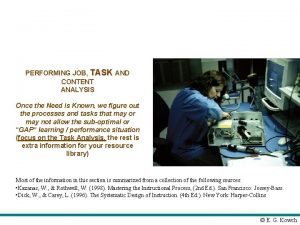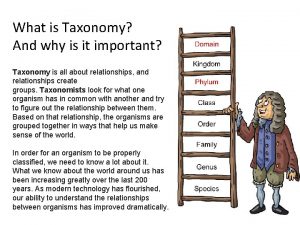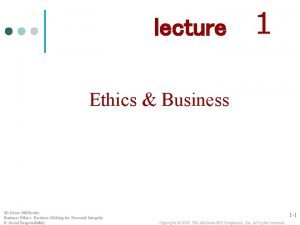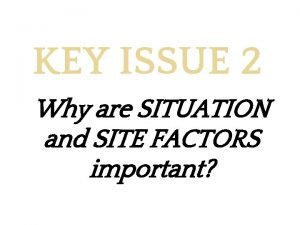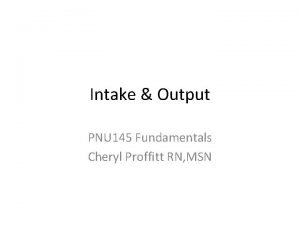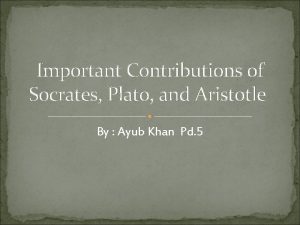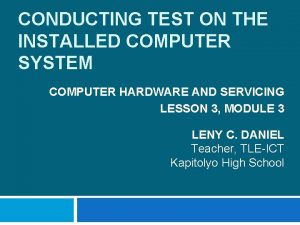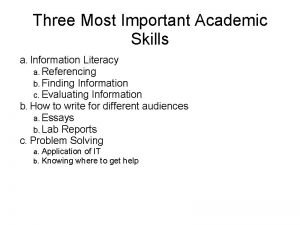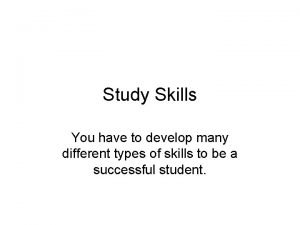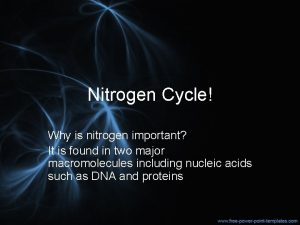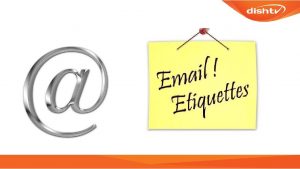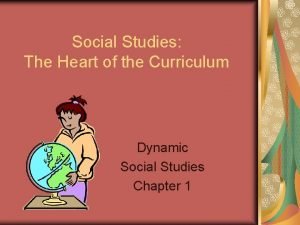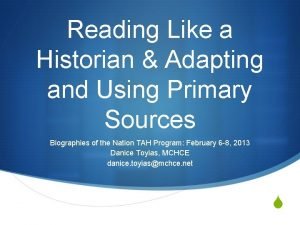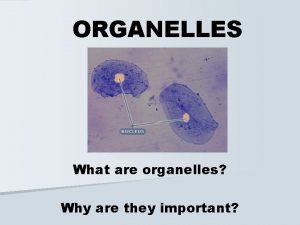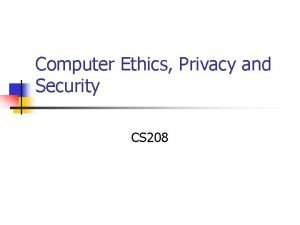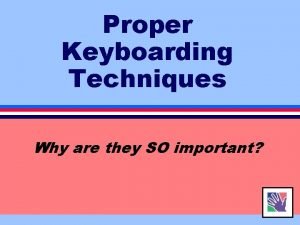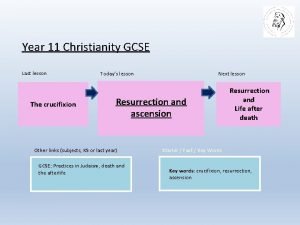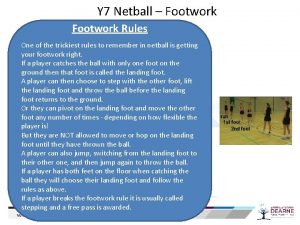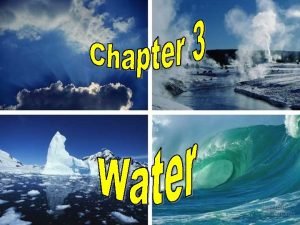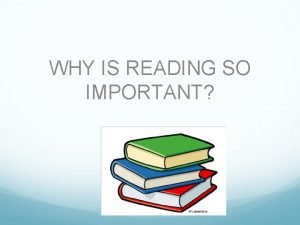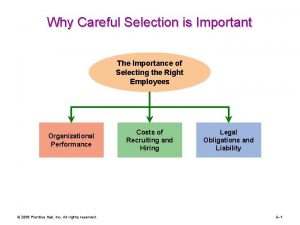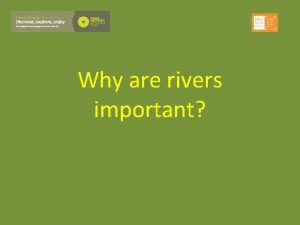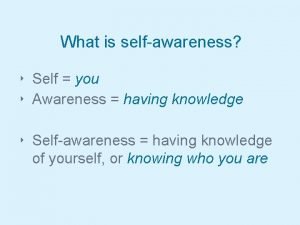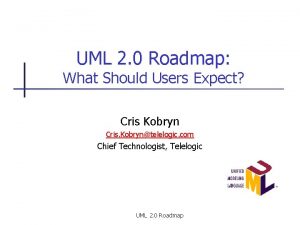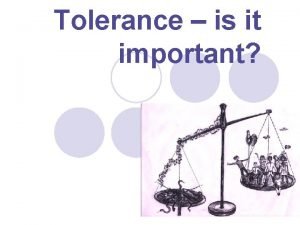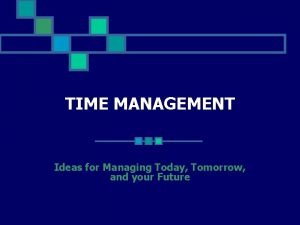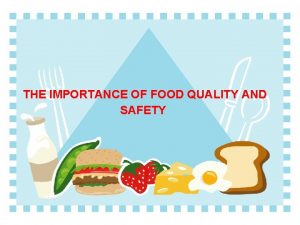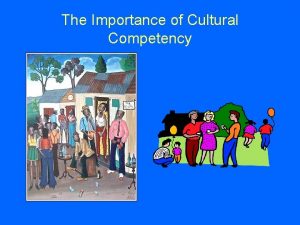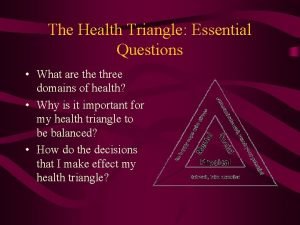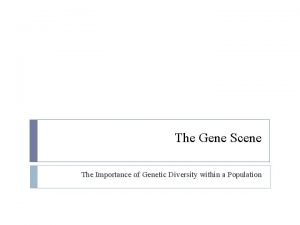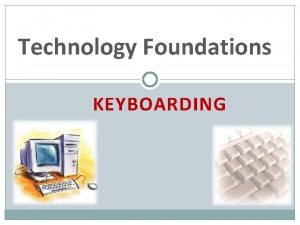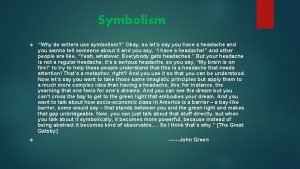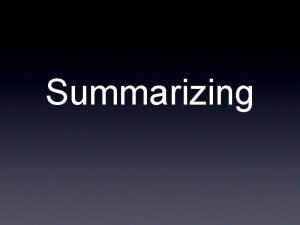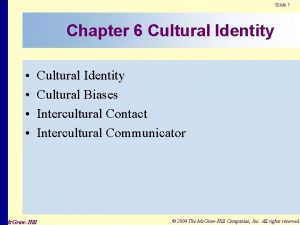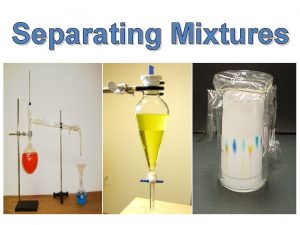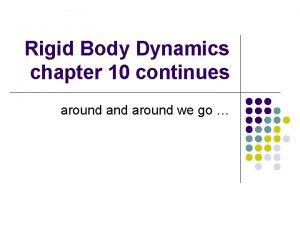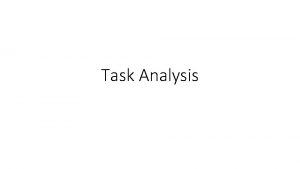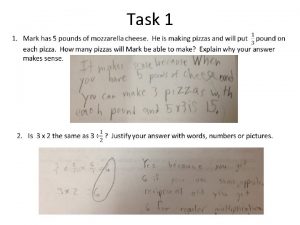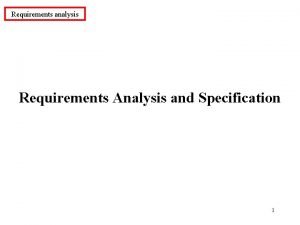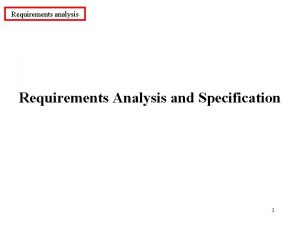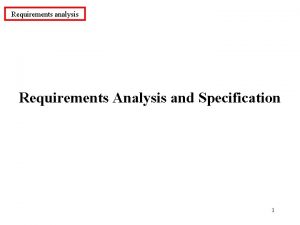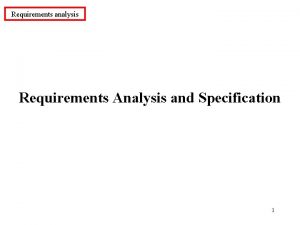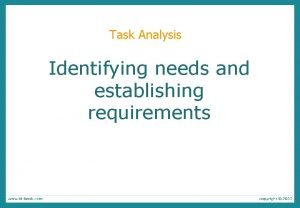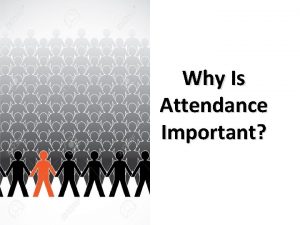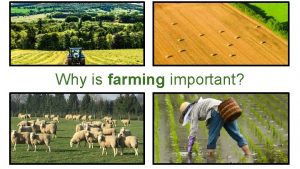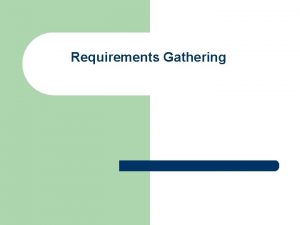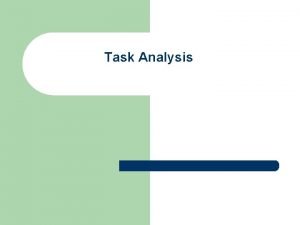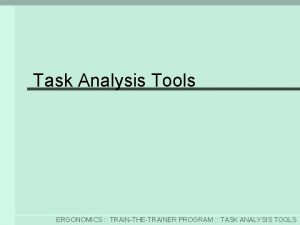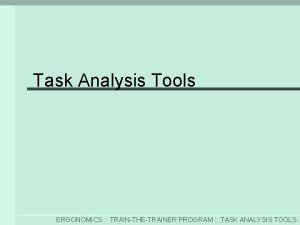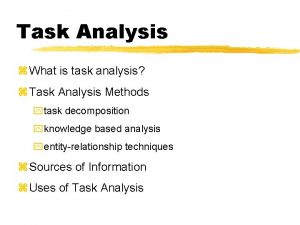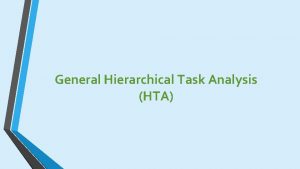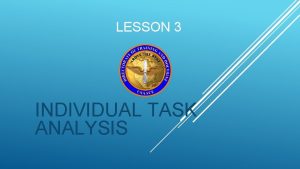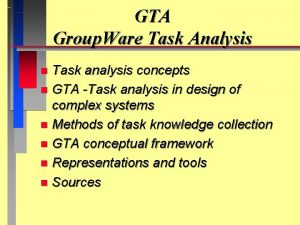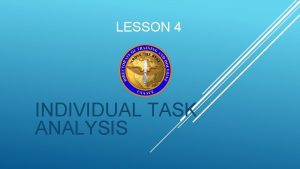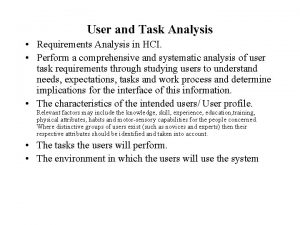Requirements and Task Analysis Why are requirements important


































































- Slides: 66

Requirements and Task Analysis

Why are requirements important? n To understand what we are going to be doing n We build systems for others, not for ourselves n Requirements definition: the stage where failure occurs most commonly n Getting requirements right is crucial

Functional vs. Non. Functional n Historically n Properties of the overall requirements n Features, functions that the system should do system n “-ilities” (quality, evolveability, flexibility, etc. ) n Environment n User requirements n Usability requirements

Not just “requirements” n Overall goals, success criteria n User characteristics n Task analysis n Environment – physical, social, technical n Constraints n Usability goals, criteria

(Not All) Requirements Gathering Methods 1. Observation 2. Thinking Out Loud & Cooperative Evaluation 3. Interviews 4. Questionnaires 5. Focus groups 6. Study Documentation 7. Look at competitive products

Know Thy User n You want to know n Who your users are n What they are doing n When they are doing it n Why they are doing it n What tools they are using n How they are using them

Human Characteristics n Physical attributes (age, gender, size, reach, visual angles, etc…) n Perceptual abilities (hearing, vision, heat sensitivity…) n Cognitive abilities (memory span, reading level, musical training, math…) n Personality and social traits (likes, dislikes, preferences, patience…) n Cultural and international diversity (languages, dialog box flow, symbols…) n Special populations, (dis)abilities

User Characteristics n Attitude, morale, willingness to change, motivation, reading level, typing skill, education, frequency of use, training, color-blindness, handedness, gender, … n Novice, intermediate, expert n System experience, task experience, computer literacy n Cultural factors n Uses of icons, colors, words, metaphors

Design implications n Consider the implications: Fact Implications Users 16 -80 yrs Range of text sizes Range of grip strength Some French speakers Multilingual interface Astronaut users Extensive training available Military context Aesthetics less of an issue Ruggedness is critical

Are Cultural Differences Important? Anna: the IKEA agent n Designed to be different for UK and US customers n What are the differences and which is which? n What should Anna’s appearance be like for other countries, like India, South Africa, or China?

Persona: describing users n Description of a user and what the user wishes to do n Put a specific human face on abstract data Be specific/detailed, even give names and picture n Easier to remember and talk about n n Two personas for ATM usage follow n Adapted from User Interface Design and Evaluation, The Open University n Developed by Cooper (1999)

Sandra (representing young adults thru middle age) Sandra is 30, is married to Jason, has two children Todd(6) and Carly (18 months). They live in a subdivision that is about three miles from the town center, where the bank and stores are located. Jason uses the car for work, and works long hours, leaving at 6: 45 am and returning at 8: 00 pm. Sandra does not drive, so has to use public transportation. She tries to run errands and shop while Todd is in school, so she only has to take Carly to town with her. She typically needs to make two trips to town each week to get everything done. She uses a stroller with Carly, and the bank is one flight up via escalator, so she prefers to use the ATM outside the first floor, even though there is no canopy to protect customers from bad weather.

Grandpa Marvin (representing middle age to senior citizens) Marvin is 68 years old, and his social security is deposited into his bank account at the start of each month. He goes to the bank every week, withdrawing enough cash for the week - for miscellaneous expenditures. Regular bills are paid by check. He stands in line for a live teller, as he prefers the social interaction to using an ATM, even though his new artificial hip makes standing in line uncomfortable. He does not have an ATM card.

Task Analysis • Process of analyzing and documenting how people perform their jobs or activities • Task-subtask decomposition • Focus on: • Activities • Artifacts • Relations • More in a moment…

Physical Environment n n n n Amount of space to work Lighting levels / directions Noise level Temperature, humidity, dust… Standing / sitting Power availability Dangers Implications?

Technical Environment n Computers/platforms for application n Technology to interact with n Networking n Mobility Implications?

Social Environment n How do users interact? Roles? n How do users interact with others? n Social implications of problem or solution? n Interruption n Privacy Implications?

Stakeholders n Primary – targeted end users n Secondary – receive output or provide input to system n Tertiary – others directly receiving benefits from system success or failure n Facilitating – design, development, maintenance

Stakeholder analysis n Cell phone n Bus stop kiosk n Nuclear power plant control system

Typical Real-World Constraints n Elapsed time to market n Cost/effort to design and implement n Size/footprint/weight/power/price n Computer power/memory (related to cost and power n Consistency with overall product line n Backward compatibility n Differentiation from competitive products

Usability Requirements n Usability goals: such as learnability, consistency, robustness, etc. n Ways to measure and judge success n n n Time to complete key tasks - min, max Time to become proficient - do given set of tasks in given time Subjective satisfaction

Example What factors (environmental, user, usability) would affect the following systems? • Self-service filling and payment system for a gas station • On-board ship data analysis system for geologists searching for oil • Fashion website for buying clothes

Example: movie ticket kiosk n List a few user characteristics n Create one persona n List a few important environmental considerations n List a couple other real world constraints

(Not All) Requirements Gathering Methods Observation Thing out Loud & Cooperative Evaluation Interviews Questionnaires Focus groups Study Documentation Look at competitive products Ethnography Contextual Inquiry

Formative vs. Summative evaluation n Summative n assess an existing system n judge if it meets some criteria n Formative n assess a system being designed n gather input to inform design n Summative or formative? n Depends on n maturity of system n how evaluation results will be used n Same technique can be used for either

Observation n Watch user(s) doing activity of interest to you n “Think out loud” or “Think aloud” n encourage user to verbalize what they are thinking n Cooperative or participative evaluation n Relaxed version of think-aloud n Evaluator and user talk to each other n Why are you doing that? n How did you know the result was what you wanted? n Are there other ways to achieve the same goal? n How did you decide to do things this way?

Observing Tips n Carefully observe everything about users and their environment n Think of describing it to someone who has never seen this activity before n What users say is important, so are nonverbal details

Interview Users n Semi-structured: predetermine sets of questions n But can expand upon them as needed n Example question types n How do you perform task x? n Why do you perform task x? n Under what conditions do you perform task x? n What do you do before you perform…? n What information do you need to…? n Whom do you need to communicate with to …? n What do you use to…? n What happens after you…? n What is the result or consequence of NOT…? See DFAB 9. 4. 4 for more tips and discussion

Focus Groups n Interview groups of users – 3 to 10 at a time n Use several different groups with different roles or perspectives n Relatively low cost, quick way to learn a lot n Use structured set of questions n More specific at beginning, more open as progresses n Allow digressions before coming back on track n More challenging to lead than single interview n Some people quiet, some dominating n Easier to get off track

Questionnaires (or Surveys) n Easier to give to broader audience n Shorter, more focused than interview n General criteria n Make questions clear and specific n Ask some closed questions with range of answers n n Sometimes also have a no opinion option, or other answer option Do test run with one or two people

Some Example Questions n Rank the importance of each of these tasks (give a list of tasks) n List the four most important tasks that you perform (this is an open question) n List the pieces of information you need to have before making a decision about X, in order of importance n Are there any other points you would like to make? (open-ended opinion question; good way to end) n Numerical scales: On a scale of 1 to 7, how comfortable are you… Or words: Strongly agree, neutral, disagree, strongly disagree

Example: movie kiosk n What to observe? How? n Who to interview? What questions? n Who to give questionnaire to? What questions? n What about focus group? n What are differences between methods?

Study Documentation n Quick and easy if it exists n Often describe how things should be done rather than how they are done n Try to understand why not done “by the book” n Alternative: interview a domain expert

Look at Competitive Products n Looking for both good and bad ideas n Functionality n UI style n Possibly do user task performance metrics to establish bounds on your system

Ethnography n Deeply contextual study n Immerse oneself in situation you want to learn about (has anthropological and sociological roots) n Observing people in their cultural context n Behavior is meaningful only in context n For UI designers: understand current methods, activities, environment, problems to aid design n Observation + interviews

Ethnography n Things of interest to evaluator n Structure and language used in work n Individual and group actions n Culture affecting work n Explicit and implicit aspects of work n Example: Office work environment n Business practices, rooms, artifacts, work standards, relationships between workers, managers, …

Drawbacks of Ethnographic Methods n Time required n Can take weeks or months for large systems n Scale n Most use small numbers of participants just to keep somewhat manageable n Type of results n Highly qualitative, may be difficult to present/use n Acquired skill – “learn by doing” n Identifying and extracting “interesting” things is challenging

Contextual Inquiry n Practical ethnographic-inspired method for requirements n Master-apprentice relationship Watch and talk to customer as they do their work n Designer looking for details and structure of work that will influence design n n Contextual interview + observation

Contextual Inquiry Principles n Context Gather information close to real situation n Avoids abstractions and summarization n Partnership n Designers help customers see and talk about structure through probing n Share design ideas in the moment n Interpretation n Designer must turn observations into useful design implications n Share this reasoning with customer to get feedback n Focus n Designer must focus on aspects of work that will be useful n For more info: see Beyer and Holtzblatt. Contextual Design. Morgan Kaufmann.

Contextual Inquiry n How compares with other methods? n Advantages? n Disadvantages? n In what situations would it be useful? n When might it not be useful?

Which Methods to Use? • Self-service filling and payment system for a gas station • On-board ship data analysis system for geologists searching for oil • Fashion website for buying clothes at large department store

Making Sense n Organize and categorize responses, comments, observations “coding scheme” n Card Sorting n Affinity Diagrams n n Task analysis

Affinity Diagram - “Sorted Cards” From Interaction Design, Preece Rogers and Sharp

Task Analysis n Focus on observable behaviors n What are the practices, methods, steps, objects, …, used? n Tasks & Subtasks Physical n Cognitive n Communication n Conditions under which these tasks are done n Results/outcomes of tasks n Requirements to perform task n Information, artifacts n Communication with others n Equipment n Also see: Hackos and Redish, User and Task Analysis for Interface Design. Wiley Publishing.

Describing activities n Scenarios n Use Cases n Task - subtask decomposition n Includes sequencing information n Workflow diagrams n Flow charts n ER or object models

Scenario n Describe tasks and context in sentences n Natural way of describing general idea n Good for demonstrating specific problems, reasons behind actions, atypical activities n Bad for representing branching, parallel activities, various possibilities of one activity

Scenario: Example 1 n Its Friday afternoon and John just got paid. He wants to deposit his check immediately so he can pay his rent. He stops at one branch of his bank on the way home from work. He waits in his car while another person finishes using the ATM in front of the bank since it is drizzling outside. He walks up to the ATM to deposit his check. Only, as he is about to put the check into the envelope at the ATM, he realizes that he has not signed the back of it, and he has no pen and can not find one on or near the ATM machine. He cancels the transaction on the ATM, and enters the bank, which luckily is still open for 5 more minutes. He goes to the counter, finds a pen, and signs his check. He also fills out a deposit slip. He then waits to see a teller in person to deposit his check, and get money for the weekend.

Scenario: Example 2 n Annie walks up to the ATM to deposit her weekly pay check. She puts her ATM card into the slot in the machine. She then enters her PIN number quickly, trying to block the person waiting behind her from viewing the keypad, and knows that she does not have to press “Enter” at this particular machine. She then chooses “Deposit” and “Check. ” She enters the amount of the check using the keypad, then takes an envelope from the ATM machine, puts her check inside, seals the envelope and writes the amount of the check on the outside. She feeds the envelope into the slot into the ATM machine. She then selects “No other transactions” to finish, and waits to receive her receipt and ATM card.

Use Case n Description of a user’s goal in using a system n Focuses on user-system interaction n One path through a use case is sometimes called a scenario n Often presented as a series of steps n Diagram of actors and use cases

Use Case Diagram

Use Case example Arrange Meeting 1. The user chooses the option to arrange a meeting. 2. The system prompts user for the names of attendees. 3. The user types in a list of names. 4. The system checks that the list is valid. 5. The system prompts the user for meeting constraints. 6. The user types in meeting constraints. 7. The system searches the calendars for a date that satisfies the constraints. 8. The system displays a list of potential dates. 9. The user chooses one of the dates. 10. The system writes the meeting into the calendar. 11. The system emails all the meeting participants informing them of them appointment

Hierarchical Task Analysis (HTA) n Graphical notation & decomposition of tasks n Goals – what the user wants to achieve n Tasks – do these to achieve the goals n n Not necessarily computer related Sequential dependencies Multiple occurrences of tasks Subtasks – lower-level tasks n Tasks organized into plans n Clusters of subtasks with a preferred order and prerequisite conditions

Task Model - Borrow Book Goal Tasks to complete goal Sequences added as annotations n Can also show hierarchy as indented text n Subtasks to carry out one task From Interaction Design, Preece Rogers and Sharp

HTA: Types of Plans n Fixed sequence n Optional tasks n Waiting events n Cycles n Time-sharing n Discretionary

HTA

Example n Goal: register for class

Flow Charts n Flow Chart of Task Steps n Complete, can become complex n Sequential flow, branching, parallel tasks. Includes actions, decisions, logic, by all elements of the system n Mature, well-known, good tools for doing it n

Flow Chart Example Start Continue? Y Document Manual Operation N Input Display End

Workflow n Documents going from one person/organization to another n Multiple participants in an activity

Workflow Example - Document Flow Create Travel Request (Traveler) Ensure Funds Available (Accounting) Approval (Dean) Notification of Approval (Dean) Make Trip (Traveler) Complete Expense Report (Traveler) Approval (Accounting) No Funds Notification of Approval (Dean) Etc

From Interaction Design, Preece Rogers and Sharp

Entity Relationship Diagrams n Object Oriented Models n Objects/people with links to related objects n Stress relationship between objects and actions n Links described functionally and in terms of strength n About relations, not procedures n Complements HTA & flow charts

Object Model: ATM n Objects n Account, ATM machine, ATM card, customer n Relations n Customer has one or more accounts n ATM machine accesses account n Actions on objects n Account: deposit($), withdraw($), balance n ATM machine: authenticate, dispense($), print receipt n Etc

Example n Create a scenario describing a CURRENT movie n n ticket buying activity – typical Create a scenario describing a CURRENT movie ticket buying activity – atypical or problem Create an HTA describing the basic movie buying activity What might you describe with an E-R or object diagram? What might you describe with a workflow or flowchart?

Beyond Requirements n Task analysis throughout life cycle: n Describe and document design ideas n Help design menu, dialog structure n Help create documentation and help n Task descriptions can be given at any necessary abstraction level

Summary n Determine what data you need n Gather it using various appropriate methods and techniques n Represent the users, environment, tasks and subtasks, plus other related information n Use this data as basis for design n Note: Be efficient!
 Mikael ferm
Mikael ferm Pictures
Pictures During the skin analysis procedure cleansing milk
During the skin analysis procedure cleansing milk Content analysis and task analysis
Content analysis and task analysis Tiered task bias task
Tiered task bias task Dont ask
Dont ask Newspaper article format
Newspaper article format Inverted pyramid in news writing
Inverted pyramid in news writing Least important to most important
Least important to most important Why-why analysis
Why-why analysis Contoh laporan root cause analysis
Contoh laporan root cause analysis Dumbking plant
Dumbking plant What is the passover and why is it important
What is the passover and why is it important What is ethics and why is it important
What is ethics and why is it important Why are situation and site factors important
Why are situation and site factors important Calculate intake and output
Calculate intake and output The brightest student of socrates.
The brightest student of socrates. Is loopback adapter a diagnostic tools
Is loopback adapter a diagnostic tools What are study skills and why are they important
What are study skills and why are they important What are study skills and why are they important
What are study skills and why are they important What is research philosophy and why is it important
What is research philosophy and why is it important Macromolecules with nitrogen
Macromolecules with nitrogen Why is email etiquette important?
Why is email etiquette important? Guiding social studies experiences
Guiding social studies experiences Assure model disadvantages
Assure model disadvantages Why social study is important
Why social study is important Read like a historian
Read like a historian What are organelles and why are they important?
What are organelles and why are they important? What is computer ethics and why is it important
What is computer ethics and why is it important 7 proper keyboarding techniques
7 proper keyboarding techniques Why is evaluating and adjusting a spending plan important
Why is evaluating and adjusting a spending plan important What is the jakota triangle and why is it important
What is the jakota triangle and why is it important When manipulating the scalp during a shampoo
When manipulating the scalp during a shampoo What are the two most important requirements for scalp care
What are the two most important requirements for scalp care Why is the ascension important gcse
Why is the ascension important gcse Why is footwork important in netball
Why is footwork important in netball Items that distort or prevent communication
Items that distort or prevent communication Why experience is important
Why experience is important Explain why strategic planning is important to all managers
Explain why strategic planning is important to all managers Why is water important to living things
Why is water important to living things Why is reading important
Why is reading important Physical ability diversity definition
Physical ability diversity definition Why careful selection is important
Why careful selection is important Why are rivers important
Why are rivers important What is selfawareness
What is selfawareness What is advent
What is advent What's ramadan
What's ramadan Why are wetlands important
Why are wetlands important Delphi technique in hrm
Delphi technique in hrm Uml 0..*
Uml 0..* L
L Why is time management important
Why is time management important Importance of quality food
Importance of quality food Why is culture important
Why is culture important Compliment examples
Compliment examples Three parts of the health triangle
Three parts of the health triangle Why is genetic diversity important
Why is genetic diversity important Importance of the sun
Importance of the sun Why is keyboarding important
Why is keyboarding important Human taxonomy
Human taxonomy Why do writers use symbols
Why do writers use symbols Summarizing is a powerful reading strategy it increase
Summarizing is a powerful reading strategy it increase Organic social media
Organic social media Why is culture identity important
Why is culture identity important Filtration used to separate
Filtration used to separate Why is the greenhouse effect important
Why is the greenhouse effect important Work done by torque
Work done by torque



